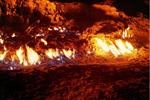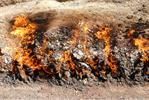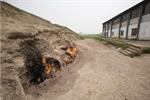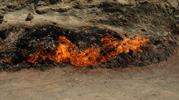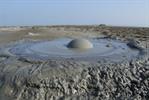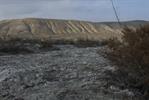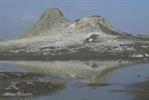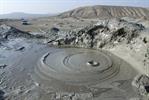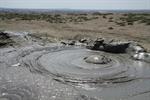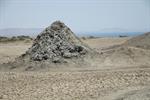Tourists and Zoroastrians alike are fascinated to see fire emerging spontaneously from the earth. The classic 'ateshgah' is the Suraxani Fire Temple (Absheron peninsula) but some visitors prefer the spooky naturalism of Yanar Dag (also Absheron peninsula). The small natural ateshgah beyond Xinaliq is in a fabulously scenic amphitheatre of mountains. There are extraordinary Yanar Bulaq burning springs at Archivan, near Qasamanli, in a river near Massally and less interestingly at Yanar Suu (near Barda).
MUD VOLCANOES (Gryazevye Vulkany) Like cows, mud volcanoes constantly fart flammable gasses. They also like throwing gobs of mud and streaming forth watery flows with a rigour that vanes seasonally. This behaviour is gently amusing rather than life threatening. Unlike 'normal' volcanoes, mud volcanoes are cold and have multiple 'gainarja' through which they exhale. These are either gryphons, distinctive, abrupt conical nozzles, or salses, bubbling watery pools. Each has its own rather lovable character and when gathered in groups they almost appear to converse. Though not unique, Azerbaijan has more of these odd 'creatures' than any other country in the world (300+ groups on land plus hundreds more offshore where they sometimes rise to form islands in the shallow coastal waters).
Where to see them?
From Baku the most accessible group is right beside the road to Shamakha. Less dramatic but even nearer there are some extinct gryphons along the Baku bypass and a crater at Lokbatan which exploded dramatically in 2001. The most interesting active groups are between Alat and Gobustan at 'Clangerland' and Bahar near Dashgil (where a recent giant mud flow is particularly impressive.
Yanar Dag
In the 13th century Marco Polo mentioned numerous natural gas flames spurting spontaneously from the Absheron Peninsula. Most, as at Suraxany, burned out when the drilling of oil wells reduced underground pressure.
However, Yanar Dag (Fire Mountain; admission free) lives on, making for one of the Absheron’s stranger sights. Locals claim that a natural gas vent on this modest hillock was accidentally ignited by a shepherd’s cigarette back in the 1958. A 10m-long wall of fire has been blazing away ever since. Extraordinary little hillside which burns day and night thanks to seeping subterranean gases which were accidentally ignited. It’s best viewed at dawn or dusk.
The site is hidden behind the lonely Yanar Dag tea house on the windswept moorland between Digah and Magomedli(Mammedli). On cold winter evenings, settle your terrace table at a distance from the flames appropriate to the evening chill. Arriving alone in the middle of the night, the atmosphere is at its most surreal with the restaurant closed and barely a car on the road - the only sound is the escaping gas licking at the slope with its multiple-flaming tongues. Although there are other such 'fireplaces' in Azerbaijan, none is as impressive nor as accessible.
Surprisingly few taxi drivers seem to known the place so you may need to give directions - going via Zabrat is easier than through Binagadi and Digah.
There are plans to gentrify the site but for now the only ‘facility’ is a semiderelict concrete сhayxana offering very pricey tea and jam.



